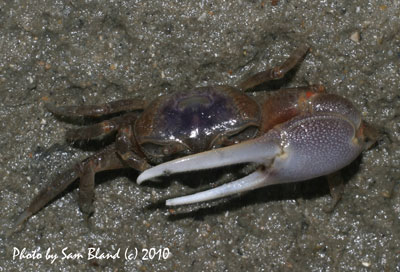Beachcombers intently surveying a cluster of oceanic gifts that marks the reach of the last high tide sometimes find an eye staring back at them. This “eye” is the dark spot at the center of a shark eye sea shell.
Sam’s Field Notes
Sam’s Field Notes: The Common Buckeye
Autumn cool fronts have erased the hazy, sticky humidity that clouds the air, leaving the sky as blue as the eye of a northern gannet. This nip in the air signals the common buckeye butterfly to begin its southern migration along the East Coast. These buckeyes are the latest broods of those that had migrated north for the summer.
Sam’s Field Notes: Sand Fiddler Crab
Anyone who has walked through the open sand flats of a salt marsh has probably heard the scurrying of little feet as a carpet of sand fiddler crabs quickly parts like the Red Sea to avoid being crushed by intruding humans.
Sam’s Field Notes: The Eastern Brown Pelican
The brown pelican has long been the proud logo of the N.C. Coastal Federation. We chose this stately bird because it is a symbol of hope, a living reminder that our coastal natural resources can withstand serious challenges. The struggles of the brown pelican, which weathered threats that brought it to the brink of extinction, mirror the challenges that continue to threaten the resources of our coast.





